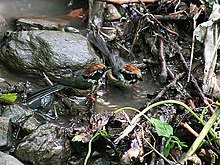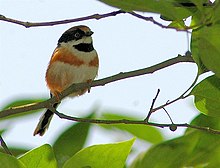Rust cap tailed tit
| Rust cap tailed tit | ||||||||||||
|---|---|---|---|---|---|---|---|---|---|---|---|---|

Rust-capped tit ( Aegithalos concinnus ) |
||||||||||||
| Systematics | ||||||||||||
|
||||||||||||
| Scientific name | ||||||||||||
| Aegithalos concinnus | ||||||||||||
| ( Gould , 1855) |
The rust-capped titmouse ( Aegithalos concinnus ) is a rather small and high-contrast bird species from the family of the tailed tit . It lives in the Himalayas , China , Myanmar and parts of Indochina . Like all species in the genus, it is very gregarious and forms small schools that roam around in search of food outside the breeding season.
description
Appearance
With a body length of 10.5 cm, the rust-capped tailed tit is smaller than a tailed tit . The tail is of medium length and therefore much shorter than that of the long-tailed subspecies of the long-tailed tit.
The eponymous head cap is rust-red or - in the subspecies A. c. pulchellus and A. c. annamensis - gray-brown. With their light yellow irises, the eyes contrast strikingly with the wide, velvety black mask that extends from the beak to the nape of the neck. The mask is only a narrow band at the beak, then becomes much wider at the upper edge in an arc parallel to the edge of the eye, narrows a little behind the eye and then becomes continuously narrower towards the neck. At the bottom it is relatively straight at first, becomes narrower behind the eye and then bulges out in a hook and then tapers in the neck. The subspecies A. c. iradalei shows a striking, white superciliar stripe at the upper edge of the mask behind the eye. A white area extends from the chin over the sides of the neck to the nape of the neck and onto the chest, within which there is a large, black throat patch that tapers to the sides, which gave the species its English name "Black-throated Tit". The top is bluish to slate gray, the wings and tail are a little darker. The outside of the tail is white. In the subspecies A. c. iradalei the underside is beige with rust-colored breast and flanks, in the other subspecies white with light rust-colored flanks and a broad rust-red chest band, which is interrupted in the middle. The strongly different subspecies A. c. annamensis has a gray-brown head cap, a brownish chest band and pink flanks.
There is no gender dimorphism . The young birds have a more matt head cap and a white chin (the black throat patch is missing). This is clearly distinguishable from the underside, at the edge on the chest a dark streaky or stained band can be seen. The white supercillary stripe above the mask is less pronounced, if present.
voice
The vocalizations are quite similar to those of the tailed tit. The contact call is a quiet psip-psip and a whirring si-si-si-si… . A stronger zap is brought forward as a cry of excitement , which often turns into a creaky chirr-trrt-trrt . The singing is a repeated, chirping tir-ir-ir-ir-ir , which is sometimes interrupted by a detached, short chirp.
behavior
Like other species of the genus, rust-capped-tailed tits are not shy, very sociable and, especially outside of the breeding season, form small swarms of up to 40 specimens. These often join flocks of other bird species. Even during the breeding season, swarms of non-breeders or pairs without breeding success can be observed. The food is mainly sought in the shrub layer, occasionally also in trees. It consists mainly of insects, but also of seeds and fruits.
As with the tailed tit, sleeping communities are formed.
distribution
The East Asian species inhabits the extreme northeast of Pakistan , northwest India ( Kashmir , Himachal Pradesh , northern Uttar Pradesh ) as well as parts of Nepal , Sikkims and Bhutan and Tibet in the Himalayas . It occurs in northeast India ( Arunachal Pradesh , Nagaland , Manipur , Meghalaya and in the extreme south of Assam and Mizoram ) and in Myanmar, where it is widespread in the northwest and northeast, leaving out large parts in the center. In Indochina it is also found in the extreme northwest of Thailand, in the north of Laos and Vietnam, and in a large sub-area in the south of Laos and Vietnam. In China, the spread of Sichuan extends through southern Gansu and Shaanxi , Henan , Anhui, and southern Jiangsu . It also settles in Taiwan . In Hong Kong she is an irregular winter visitor.
The rust-capped tit is primarily a resident bird . In addition to occasional dispersions , it only occasionally migrates from higher altitudes in colder winters.
Geographic variation
The six subspecies of the rust-capped tit can be divided into three groups.
Iradalei group
White Supercillium and a very solid rust beige underside, missing or weak white chest band.
- A. c. iradalei ( Stuart Baker , 1920) - Himalayas from northern Pakistan to northeast India, southwest China
Concinnus group
No white Supercillium, rust-brown flanks and rust-red chest band on the white underside.
- A. c. manipurensis ( Hume , 1888) - Northeast India and western Myanmar
- A. c. concinnus ( Gould , 1855) - East-Central China and Southeast China, Northeast Vietnam , Hainan, and Taiwan
- A. c. talifuensis ( Rippon , 1903) - Northeast Myanmar, South China, North and East Laos, and Northwest Vietnam
- A. c. pulchellus ( Rippon , 1900) - Eastern Myanmar and Northwest Thailand
Annamensis group
Beige underside with brownish chest band and flanks that play into pink.
literature
- S. Harrap, D. Quinn: Chickadees, Tits, Nuthatches and Treecreepers , Princeton University Press, Princeton / New Jersey 1995. ISBN 0-691-01083-8
Web links
- Aegithalos concinnus in the endangered Red List species the IUCN 2008. Posted by: BirdLife International, 2008. Accessed July 28 of 2009.
- Videos, photos and sound recordings of Aegithalos concinnus in the Internet Bird Collection

